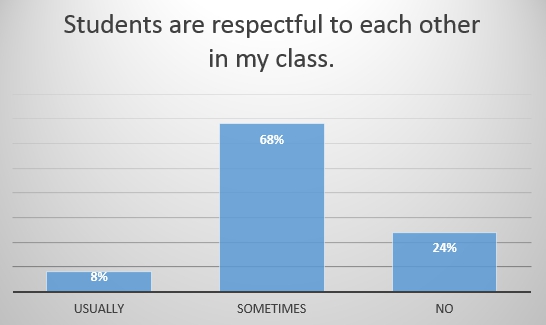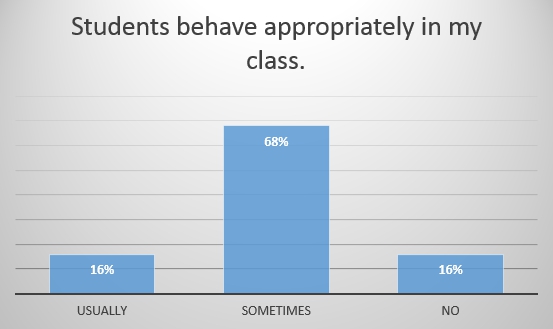This year, my Student Survey results held few surprises (link to view last year’s Student survey analysis). Items directly related to me, such as ‘My teacher cares about me’, were positive. Generally, 70-80% of students answered ‘usually’ with very few, most often only one student, answering ‘no’.
Listening to students
One surprise was the response to the statement, ‘My teacher listens to me.’, to which 48% of my students think I only ‘sometimes’ listen to them. Slightly baffled, I reflected on my practice and identified a few of my behaviors that could lead to this result.

First, as a rule, I ignore students when they suddenly shout across the classroom, begin asking a question without saying ‘excuse me’ or otherwise catching my attention, and especially interrupt other students. I can easily understand how a child could perceive that I am not listening to them because in some cases, I intentionally don’t listen in order to cultivate a culture in the classroom of politeness.
Of students who responded ‘sometimes’ or ‘no’, their overall average response was only 69% positive, meaning that those who responded negatively to this item were also negative to most of the other items. Of those who don’t feel that I ‘usually’ listen to them, 69% also don’t feel free to ask and answer questions, a tenuous correlation.

As a simple action plan, I would follow the steps below.
1 Observe if and when I don’t listen to students.
2 Make more explicit that I sometimes ignore students speaking to me if they are acting disrespectfully or impolitely.
3 Reinforce our classroom essential agreement – which was composed, synthesized, and signed by all of the students – about being Open-minded Communicators.
We are Open-Minded Communicators.
We have a right to share our opinions and feelings.
We have a responsibility to show respect by listening and practicing empathy.
I would also note that of all of the classes I have taught in nine years, this is by far the most needy. During any written assessment, there is a constant queue at my desk and barrages of hands in the air asking for help. My email box is also consistently populated by emails from students asking to send PDFs of lost homework and other requests for favors which I politely decline. It is possible that their concept of the role of a teacher is significantly different than mine.
Choice and agency
A difference in expectations might illuminate another perplexing survey item result to the statement, ‘My teacher allows me to demonstrate my understanding in various ways.’

For their first unit Summative Assessment Task, students had the instruction to ‘Present your research findings in an appropriate medium of your choice (written report, video, poster, dance, cooking, etc).’
Almost everyone in the class chose to do an oral presentation with a poster or PowerPoint for visual support. The remaining two students submitted written reports. Although this may only be a case of carefully reading and following instructions, I feel justified in being somewhat annoyed.
Respect and classroom behavior
I was shocked to discover their responses to the statement, ‘Students are respectful to each other in my class.’

Only two students think that their peers ‘usually’ treat each other with respect, and almost a quarter feel that their class is always disrespectful. The same holds true for their perceptions of classroom behavior.

When I asked if anyone wanted to learn in a class like the one shown above, no one responded.
I have discussed these results with my grade level team, administration, and the precious grade teachers. All assured me that the students’ feelings about their community are absolutely about complex social dynamics. In brief, this class has too many ‘alphas’ and not enough empathy. This is a case study to test my ability to cultivate social and emotional intelligence. And a fair and timely challenge it is.
A future post will detail the reflection and data informed action plan I have set into motion to help this learning community to become more Caring.
I would certainly appreciate anecdotes and suggestions that might more brightly illuminate a path forward.






